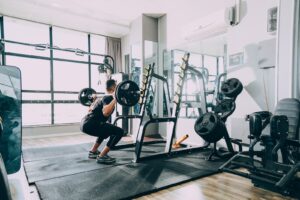
Creating a peaceful and distraction-free environment is crucial for any gymnasium. Unwanted noise and echoes can hinder concentration, impact athletic performance, and disrupt neighboring areas. Thankfully, soundproofing techniques offer effective solutions to mitigate these issues. In this comprehensive guide, we will explore the best strategies and practical steps on “How To Soundproof A Gymnasium”.
There are quite a few effective ways you can soundproof a gymnasium, and those methods would be shared in this guide.
Here are the ways you can soundproof a gymnasium.
- The use of acoustic panels.
- Using insulation.
- Flooring treatments.
- Soundproof partitions or curtains.
- Using sealing or weatherstripping.
Contents
The use of acoustic panels
Installing acoustic panels on the walls and ceilings of the gymnasium helps absorb sound energy, reducing reverberation and echo.
These panels are typically made of sound-absorbing materials such as foam, fabric-wrapped fiberglass, or perforated wood.
However, installing acoustic panels requires you to be discrete in order to make the acoustic effective in absorbing sound.
Knowing this, we’ve prepared a step-by-step guide that will help you install the acoustic panel in your gymnasium.
Step 1: Assess the Acoustic Needs
Before installing acoustic foams, it’s crucial to assess the specific acoustic needs of your gymnasium.
Consider the size of the space, the activities conducted, and the current acoustic challenges you are facing. Identify areas with high sound reflection and determine the quantity and placement of acoustic panels required.
Step 2: Measure the Area
Measure the dimensions of the walls and ceiling where you plan to install the acoustic panels.
This measurement will help you determine the number of panels you need to cover the desired surfaces adequately.
It’s recommended to have an accurate floor plan or layout of the gymnasium to plan the panel placement effectively.
Step 3: Select the Right Panels
Choose acoustic panels that suit your gymnasium’s aesthetics and acoustic requirements. There are various types of panels available, such as foam panels, fabric-wrapped fiberglass panels, and perforated wood panels.
Consider factors like absorption coefficient, NRC (Noise Reduction Coefficient) rating, and fire safety ratings when selecting the panels.
Step 4: Plan the Panel Placement
Based on your assessment and measurements, create a plan for panel placement. Focus on areas with high sound reflection, such as walls near basketball hoops, seating areas, or the back of the gymnasium.
The goal is to strategically position the panels to maximize sound absorption and minimize sound reflections.
Step 5: Prepare the Surfaces
Before installing the panels, ensure that the surfaces are clean, dry, and free from any dust or debris.
This will promote proper adhesion and longevity of the panels. Clean the walls and ceiling using a mild detergent or appropriate cleaning solution, and let them dry completely.
Step 6: Install Mounting Hardware
Determine the appropriate mounting hardware for your chosen acoustic panels. This can include adhesive, brackets, clips, or hooks, depending on the panel type and the surface material of your gymnasium.
Follow the manufacturer’s instructions to securely attach the mounting hardware to the walls and ceiling.
Step 7: Attach the Acoustic Panels
Carefully attach the acoustic panels to the prepared surfaces using the chosen mounting hardware.
Ensure that the panels are aligned properly and securely fastened. If using adhesive, follow the manufacturer’s guidelines for the appropriate amount and placement of adhesive on the back of the panels.
Step 8: Consider Panel Layout
Pay attention to the layout and pattern of the panels. Depending on the design and size of the panels, you can create an aesthetically pleasing arrangement.
Experiment with different panel orientations, alternating panel types, or creating patterns to achieve a visually appealing result while maintaining optimal sound absorption.
Step 9: Test and Adjust as Needed
After installing the acoustic panels, conduct sound tests and evaluate the acoustic performance in the gymnasium.
Listen for improvements in sound quality, reduction in reverberation, and enhanced speech clarity. If necessary, make adjustments to the panel placement or add additional panels in areas that require further soundproofing.
Step 10: Regular Maintenance
Regularly inspect the acoustic panels for any signs of damage, wear, or loosening. Clean the panels according to the manufacturer’s guidelines to maintain their performance.
Replace any damaged or worn-out panels promptly to ensure the continued effectiveness of the soundproofing solution.
Using insulation
Adequate insulation within the walls and ceiling cavities can minimize sound transmission from adjacent rooms or external sources.
Using sound-dampening insulation materials, such as mineral wool or recycled denim insulation, can significantly reduce noise infiltration and improve the overall soundproofing of the gym.
Flooring treatments
Flooring solutions play a crucial role in soundproofing a gymnasium as they help absorb impact noise generated by activities like jumping, weightlifting, and running.
You can make use of resilient floorings, such as rubber or vinyl, which is an excellent choice for gymnasiums. These materials have shock-absorbing properties that help cushion the impact of activities and reduce the transmission of sound.
Another option is using floating floors. It consists of an underlayment layer that acts as a shock absorber and a top layer of flooring material.
The underlayment, often made of rubber or foam, helps isolate the gymnasium floor from the building structure, reducing the transfer of impact noise.
Soundproof partitions or curtains
Large gymnasiums often require sectioning off specific areas for various activities simultaneously.
Installing soundproof curtains or partitions can provide an effective way to control noise and create separate sound zones within the gymnasium.
These barriers help reduce sound transmission and maintain a more controlled acoustic environment.
Using sealing and Weatherstripping
Lastly, the use of sealing and weatherstripping can help soundproof a gymnasium. Ensuring proper sealing of doors, windows, and any other openings is essential to prevent sound leakage.
Use weatherstripping materials, such as door sweeps and window seals, to seal gaps and cracks that may allow sound to escape or enter the gymnasium.
Also Read: How to stop jeans from making a popping noise when walking
Do rubber gym mats absorb sound?

Yes, rubber gym mats absorb sound. However, they have to be installed in the right way to reduce sound. Rubber gym mats can help reduce and absorb sounds to some extent, but their effectiveness will depend on various factors such as the thickness and density of the mats, the type of flooring they are placed on, and the intensity of the sounds involved.
Rubber mats have inherent properties that make them capable of absorbing impact and vibrations, which can contribute to sound reduction.
When weights or exercise equipment are dropped on rubber gym mats, the impact and resulting vibrations are absorbed to a certain degree, minimizing the noise produced.
This can be particularly beneficial in environments where noise reduction is desired, such as home gyms, commercial fitness centers, or areas adjacent to living spaces.
What are the importance of soundproofing a gymnasium?
Soundproofing a gymnasium is essential to create a conducive environment for various reasons that would be listed and discussed below.
Here are the importance of soundproofing a gymnasium.
Noise control
Gymnasiums are typically large spaces with hard surfaces that can cause sound to reverberate and amplify.
This can lead to a high noise level, making it difficult for people to communicate, concentrate, or hear instructions clearly.
Soundproofing helps control the noise within the gymnasium, creating a more comfortable and productive environment for participants, instructors, and spectators.
Improved acoustics
Proper soundproofing can enhance the acoustics of a gymnasium by reducing echoes, reverberation, and excessive background noise.
This is particularly important for activities such as sports events, group fitness classes, or performances where clear and intelligible sound is necessary.
Improved acoustics can enhance the overall experience for participants and ensure that important announcements or instructions are easily heard.
Privacy and confidentiality
In some cases, a gymnasium may be used for sensitive activities such as physical therapy sessions, private training sessions, or confidential discussions.
Soundproofing helps maintain privacy by preventing sound from escaping the gymnasium and reaching outside areas. This ensures that conversations and activities within the gymnasium remain confidential and secure.
Neighborhood considerations
Gymnasiums located in residential or commercial areas need to be mindful of the impact of noise on the surrounding environment.
Excessive noise from a gymnasium can cause disturbances to nearby residents, businesses, or other facilities.
Soundproofing helps minimize noise transmission, reducing the likelihood of complaints or conflicts with neighbours.
Compliance with regulations
Many jurisdictions have regulations or building codes that dictate acceptable noise levels for different types of spaces, including gymnasiums.
Soundproofing the gymnasium ensures compliance with these regulations, avoiding potential fines, penalties, or legal issues.
Safety and concentration
Excessive noise levels in a gymnasium can be distracting and may impact safety. In sports activities, clear communication between coaches and athletes is essential to prevent accidents or injuries.
Soundproofing helps create an environment where participants can focus on their activities without being hindered by excessive noise, leading to a safer and more productive workout or sports session.
Conclusion – How To Soundproof A Gymnasium
The need for soundproofing a gymnasium comes up when there are no excellent acoustics, privacy, or noise control, or when there are complaints from neighbors closer to the gym.
However, it is important to know the available methods that can be used to soundproof a gym, and they have been listed and elaborated on in this blog post.

Pingback: How To Make A Gas Golf Cart Quieter - A Step-By-Step Guide! -
Pingback: How To Soundproof A Warehouse - An Easy Guide! -
Pingback: The Best Quiet Punching Bags For Apartment Use (2023) -